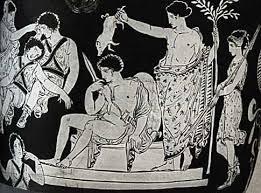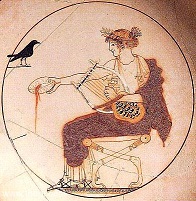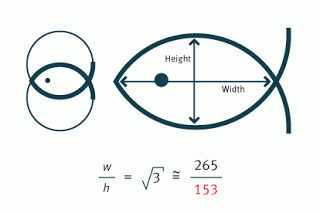|
Apollo

Alias: Apollon
Location: Asia Minor (Turkey), Greece, Rome
Cities: Delphi (Greece), Delos (Greece), Arta (Greece), Troy (Turkey), Wilusa (Turkey), Rome
Estimated Date: 700s B.C. - 500s A.D.
He is a shepherd and lyre player

Apollo is known to be a shepherd and lyre player and was assocaited with intelligence, music, philosophy, purity, pestilence and medicine. Some modern scholars believe he is a combination of a northern Dorian shepherd god from 1000s B.C., similar to Dumuzi or Adonis, and a Hurrian plague god from the 800s or 900s B.C.,
Aplu, from the Akkadian title Apal-Enlil, meaning “son of the lord of air”, given to the king of the netherworld, Nergal, husband to Inanna/Ishtar's zombie queen sister, Ereshkigal. Apollo was associated with the sun in Greek philosophy around the 400s B.C. but there is little evidence he was worshipped as a sun god before then. He had a war-like twin sister, the virgin huntress Artemis, equivalent to Ba’al Hadad’s warrior-companion and sister Anat, but also similar to how the Sumerian sun god Utu’s twin sister was Inanna. His character is much closer to that of the Ba’als in that he hunts, founds cities, and does not die and resurrect, but like Dumuzi and Attis and unlike the Ba’als, Apollo and Artemis are agents of the mother goddess, slaying her enemies.
A dragon tries to devour his mother before he is born, just like in the Book of Revelation

Apollo fighting Python with a bow and arrow
Apollo and Artemis slay a dragon named Python, or Drakaina, after the dragon tries to devour their mother to stop them from being born, just as the red dragon in Revelation does.
Whosoever met the Drakaina [Python], the day of doom would sweep him away, until the lord Apollon, who deals death from afar, shot a strong arrow at her. Then she, rent with bitter pangs, lay drawing great gasps for breath and rolling about that place. An awful noise swelled up unspeakable as she writhed continually this way and that amid the wood: and so she left her life, breathing it forth in blood.
Python knew that Latona [Leto] was pregnant by Jove [Zeus], he followed her to kill her. But by order of Jove the wind Aquilo carried Latona away… [to Ortygia where] clinging to an olive tree, she bore Apollo and Diana [Artemis], to whom Vulcanus [Hephaestus] gave arrows as gifts. Four days after they were born, Apollo exacted vengeance for his mother. For he went to Parnassus and slew Python with his arrows.
Now a great sign appeared in heaven: a woman, robed with the sun, standing on the moon, and on her head a crown of twelve stars. She was pregnant, and in labour, crying aloud in the pangs of childbirth. Then a second sign appeared in the sky: there was a huge red dragon with seven heads and ten horns, and each of the seven heads crowned with a coronet. Its tail swept a third of the stars from the sky and hurled them to the ground, and the dragon stopped in front of the woman as she was at the point of giving birth, so that it could eat the child as soon as it was born.
He is the Fifth Angel of the Apocalypse in Revelation
The fifth angel of the Apocalypse, Apollyon, is described as king with the power over locusts, which fits Apollo's identity as a god of pestilance. Apollo is also identified with the Hebrew Abaddon, which in the Old Testament seems to be equivalent to the Greek Tartarus, the place of destruction within Hades, or Sheol, but in the Acts of Thomas, dated to the 200s A.D., he is a demon or the devil.
They had as king over them the angel of the Abyss, whose name in Hebrew is Abaddon and in Greek is Apollyon (that is, Destroyer).
-Revelation 9:11, NIV
He is associated with the serpent pole that was used for healing by Moses and referenced by Jesus as a symbol of resurrection
Apollo is said to have traded his caduceus to Hermes for a lyre. One of Apollo's demi-god sons, Asclepius, a healer said to have lived around 1200 B.C., also carried a rod with a snake wrapped around it. According to the Pythian Odes of the poet Pindar, written in the 500s B.C., Asclepius learned how to use drugs, love potions, and incantations. Asclepius was said to have been killed by Zeus, either for selling Gorgon blood or resurrecting the god Hippolytus, causing Apollo to take revenge by killing the Cyclops who fashioned Zeus' lighning bolts.
He hangs a flute-playing shepherd associated with Dionysus on a tree and flays him
In another version of the myth from Pseudo-Apollodorus in the 100s, Apollo and Artemis shot down the giant Tityos as he tried to rape their mother Leto, after which Tityos is punished by having vultures eat his ever-regenerating heart in Hades, similar to Prometheus’ punishment. Homer’s Odysseus also says he saw Tityus in the underworld having his ever-regenerating liver eaten by vultures, which is even closer to Prometheus’ punishment, though Apollo or Artemis are not mentioned. The name Tityos may be connected to Tityroi, a Boiotian name for the satyrs, the flute-playing, horse-like companions of the wine god Dionysus. Another enemy of Apollo similar to Dionysus is Marsyas, a shepherd flute-player who challenges Apollo to a music contest and loses, after which Apollo hangs him on a tree and flays him. The first century Greek geographer Strabo connected Marysas to Dionysus and the Phrygian rites. Since the serpent totem is linked to Dumuzi, Tityos can be linked to Dionysus, and Orpheus was said to have tried to reform Dionysus to Apollo, these myths of conflicts of Apollo can be interpreted as an attempt to reform the shepherd religion to the city-state and imperial values. Both Apollo and Marysas competed as servants of the mother goddess, which explains why the conflict is portrayed as sons and daughters slaying a giant trying to rape their mother. Marsyas eventually became a symbol of anti-Roman Italians in the first century B.C. Social War and then, after the Emperor Augustus took on the role of Apollo, a symbol for anti-imperialism, so much so that Augustus exiled his daughter Julia, who during some “nocturnal debaucheries”, crowned a statue of Marsyas to defy him, as well as the poet Ovid, whose mysterious exile by Augustus could possibly have been related to his own stories of Apollo flaying Marsyas.
"[Athena] threw away the pipes [she had invented] and vowed that whoever picked them up should be punished severely. Marsyas, a shepherd, son of Oeagrus, one of the Satyri, found them, and by practicing assiduously kept making sweeter sounds day by day, so that he challenged Apollo to play the lyre in a contest with him. When Apollo came there, they took the Musae (Muses) as judges. Marsyas was departing as victor, when Apollo turned his lyre upside down, and played the same tune--a thing which Marsyas couldn't do with the pipes. And so Apollo defeated Marsyas, bound him to a tree, and turned him over to a Scythian who stripped his skin off him limb by limb. He gave the rest of his body for burial to his pupil Olympus. From his blood the river Marsyas took its name."
P. Munatius, having placed upon his head a chaplet of flowers taken from the statue of Marsyas, was condemned by the Triumviri to be put in chains. Upon his making appeal to the tribunes of the people, they refused to intercede in his behalf —a very different state of things to that at Athens, where the young men, in their drunken revelry, were in the habit, before midday, of making their way into the very schools of the philosophers even. Among ourselves, no such instance of a similar licentiousness is to be found, unless, indeed, in the case of the daughter of the late Emperor Augustus, who, in her nocturnal debaucheries, placed a chaplet on the statue of Marsyas, conduct deeply deplored in the letters of that god.

Statue of Marsyas
He was worshipped in mystery cults that had a baptism sacrament performed for the remission of sin
The third century apologist Tertullian compares the baptism of the Apollinarian mysteries to that of Isis, Mithras and the Eleusinian mysteries and says the baptism sacrament was done to atone for sin.
For washing is the channel through which they are initiated into some sacred rites— of some notorious Isis or Mithras. The gods themselves likewise they honour by washings. Moreover, by carrying water around, and sprinkling it, they everywhere expiate country-seats, houses, temples, and whole cities: at all events, at the Apollinarian and Eleusinian games they are baptized; and they presume that the effect of their doing that is their regeneration and the remission of the penalties due to their perjuries.
The number of fish that Jesus miraculously catches may refer to a mystic number from his “son”, Pythagoras
One of the mystery cults from the 500s B.C. was led by the philosopher and mathematician, Pythagoras, who is famously credited with discovering the proof for the Pythagorean Theorm a2 + b2 = c2, although the theorm itself had been used at Babylon and India before then. He was said to have received his teachings from the priestesses of Apollo at Delphi, known as the Pythia, from which Pythagoras' name suppossedly derives. According to Aristotle, the people of Croton called him the “Hyperborean Apollo” and a Samian poet refers to him as Apollo's son. Like most mystery cults, Pythagoras' adherents were both celebate and vegetarians. One story regarding the vegetarianism of Pythagoras is that when he successfully guessed the number of fish in a large net on a wager that the fishermen let the fish go. This story has been compared to the stories in the gospel in which the disciples are unable to catch any fish until Jesus tells them to try again, after which they catch a miraculously large number of fish, a myth obstensibly about Jesus' ability to bring in mass conversions, but in the version of the story at the end of the Gospel of John, the exact number of fish is given: 153. The number 153 is a triangular number, which were sacred to the Pythagoreans. It is only one of many, but more interestingly, going back at least as far as the 200s B.C., the fraction 153/256, the square root of 3, was known as the ratio of two intersecting circles, called the “Measure of the Fish” because the intersecting area of the “Venn Diagram” and the “tail” end looked like the ichthys fish. There are other theories about what the number 153 signifies, such as a letter-code for Magdalene, but the symbolic relationship between the fishing stories and the Measure of the Fish makes for the most tantalizing connection even without the presumably lost reference to 265.

Picture taken from Richard's Theory of Everything
One of his priests was said to have become an important Christian prophet
Montanus, the leader of the “New Prophecy” of Jesus in the late second century and who claimed the cities of Pepuza and Tymion in Phrygia as the site of the “New Jerusalem” of Revelation, was said to have formerly been a castrated priest of the mystery cult of Cybele. But according to a Dialogue Between a Montanist and an Orthodox, quoted by the fourth century theologian Didymus the Blind, Montanus was a priest of Apollo. This need not be a contradiction, however, as Apollo was also associated with Cybele in the area of Asia Minor (Turkey). The fourth century bishop Epiphanius quoted a saying from Montanus that compared man to a lyre, which is what Apollo and Orpheus are always portrayed with, and Montanism was particularly influenced by Johannine literature, including Revelation, which could explain the dragon chasing after the pregnant woman parallel. The version of the Book of Revelation that has come down us may have been a version with Montanist material added to it. 1 Corinthians seems to have been written with them in mind since it is an attempt to limit speaking in tongues, which was rampant in Montanism. Montanism was controversial but more generally accepted within the Apostolic Church than the Gnostic and Marcionite sects and survived until the 700s. The third century Church Father Tertullian himself defended the “New Prophecy” of the Montanists in seven books that failed to survive.

Next God: Mithras
The Dying-and-Rising Gods
Leave Comments Here
|

